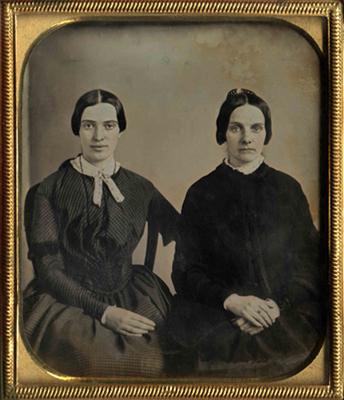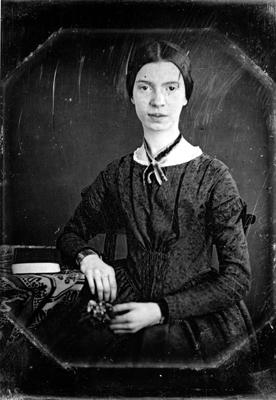by William Sweet
Imagine having the whole world judge you on a single snapshot—one taken when you were 16.
It sounds like the beginning of some cringe-inducing Facebook horror story, but in this case it’s the story of Emily Dickinson, one of America’s best-known yet most enigmatic poets. Though she left behind a substantial body of poems and letters, our only image of the “Belle of Amherst” has always been a single photograph, taken of her as a teenager in 1847, years before she wrote any of the known poems. Reportedly, she did not like the portrait, and her family felt it was not a good likeness. Nonetheless, that photograph —a possession of Amherst College Archives and Special Collections— is the source for countless copies and interpretations, from paintings to dolls to computer-animated shorts of her reading her poems.

Is this Emily Dickinson (left) circa 1860?
Hence the excitement currently emanating from the archives and the Emily Dickinson Museum, which has spread to The Guardian, The New York Times, Daily News and other media outlets, over a recently discovered daguerreotype that some experts say is a picture of Dickinson when she was 30, at the height of her craft.
The new photograph may just change many people’s assumptions about the poet, who has markedly different bearing in the later photo, said Michael Kelly, head of Archives and Special Collections. “In this new one, she is staring straight into the camera. She is a very self-possessed woman,” he said.
Every few years, someone will come forward with a photograph that they believe may be of Dickinson, but even the most serious contenders have been discredited by experts.
What’s different this time around? Two major factors are Emily’s eyes and Emily’s friend. The new daguerreotype, purchased at an estate sale in Springfield in 1995 by a collector who chooses to remain anonymous, depicts two women seated side by side. The collector said he had a hunch at the time he acquired it that the woman sitting on the left might be Dickinson, and he set out to determine who the other woman might be. Following some years of investigation into the poet’s life, he identified the second woman as Catherine Scott Turner (later Anthon), a friend of the Dickinson family. He picked out Kate Scott (as the family called her) by the two distinctive moles visible below either side of her mouth, which matched other portraits of the woman.
The collector believes the photograph to have been taken around 1859 or 1860, possibly by Springfield, Mass., photographer J. C. Spooner.
The original daguerreotype of the two women is thought to have been taken during one of Kate’s visits to Amherst. Amherst College’s copy of the daguerreotype, a sixth plate (2.75 x 3.25 inches), was commissioned for us by the owner of the original and photographed by Canadian daguerreotypist Mike Robinson in 2009. The Emily Dickinson Museum owns a second copy made at the same time.
A team of experts, including Archives and Special Collections Specialist Margaret Dakin, have been closely examining the photograph with a variety of tools, and the results have been encouraging.
“In Photoshop, it’s a crazy-perfect fit” between the 1847 and 1859–60 portraits, said Kelly.

The 1847 daguerreotype of Dickinson
Polly Longsworth, historian and member of the board of governors of the Emily Dickinson Museum, facilitated a report conducted by Dartmouth Hitchcock Medical Center ophthalmologist Dr. Susan Pepin, who carefully examined the eyes in the new image and compared this feature with Dickinson’s eyes in her 1847 portrait. Director of neuro-ophthalmology at Dartmouth’s Geisel School of Medicine, Pepin has long been interested in Dickinson’s eye problems, which include a recognizable astigmatism in one eye. After taking precise measurements of distinct characteristics of the eyes from enlarged images of both daguerreotypes (mirror images that show features reversed), she believes that the two portraits are of the same person. Other facial features Pepin finds identical in both portraits are the position of Dickinson’s right earlobe and the configuration of the area between the nose and upper lip.
Clothing worn by the two figures in the daguerreotype has offered additional clues. There is a marked similarity in the style of dress worn by the Dickinson figure in the new picture to that worn by the poet in the earlier portrait. According to preliminary observations of clothing historians, the gown in the new picture appears to be about a decade out of date, its fashion popular in the late 1840s. Some biographers have noted that Dickinson was not particularly style-conscious in her attire. Turner’s mourning garments, however, date from her first husband’s death in May 1855, establishing a time after which the portrait must have been taken.
A swatch of blue-checked fabric in the collections of the Emily Dickinson Museum is similar in pattern and sheen to that worn by the left-hand figure in the daguerreotype. Further study of the fabric worn in the new daguerreotype would be needed to know whether it matches the museum’s swatch.
“This is a fascinating development,” said Jane Wald, executive director of the museum. “Dickinson’s most prolific period of writing occurred while she was in her early 30s. After viewing her always at age 16, seeing a woman who could be the adult Emily Dickinson, a working poet, reshapes one’s thinking.”
“The museum heartily encourages close study of this new image,” she said.
Material from the website for the Emily Dickinson Museum was used for this article.